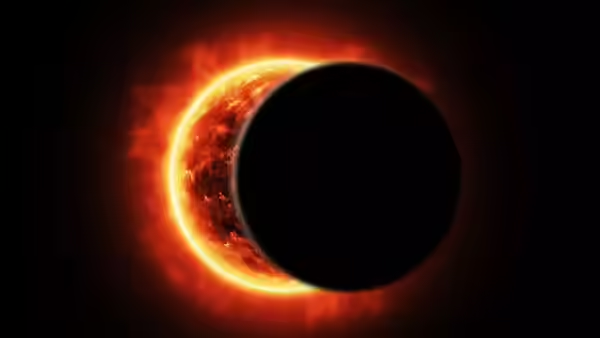ORLANDO – NASA reports that this August, people around the world are looking forward to a stunning sight in the sky: a total solar eclipse on 2 August 2025. For a short time, the moon will move directly in front of the sun, casting a shadow over certain areas and turning day into night.
Thailand, including Chiang Rai in the north, won’t see the full eclipse. Yet the event still gives Thais a reason to celebrate astronomy and look ahead to chances to see a total eclipse in their own country.
Where and When Will the Total Eclipse Happen?
On 2 August, the moon will pass between the Earth and the sun, blocking sunlight for parts of the world. According to NASA, the eclipse will start over the Pacific Ocean. The path where the sun gets completely blocked, known as the path of totality, will begin at about 4:51 pm UTC (which is 11:51 pm in Thailand). At its longest, the total phase will last around 4 minutes and 28 seconds near the Midway Atoll.
The shadow will cross parts of the Pacific, northern California, and the northwest United States. It will then move across the Atlantic and reach spots in Europe such as Iceland, Ireland, and northern Spain. In these areas, the sky will turn dark, the sun’s outer atmosphere (called the corona) will be visible, and stars may even appear for a few minutes. Since Thailand sits far from this path, no part of the country, not even Bangkok or Chiang Rai, will see the eclipse— not even a partial version.
This might be disheartening for some Thai stargazers, but the event still sparks interest. Places like the National Astronomical Research Institute of Thailand (NARIT) plan to stream the eclipse live and offer activities to get the public involved. In Chiang Rai, the local planetarium will hold a watch party with telescopes and safe solar filters. People will be able to learn about eclipses and safely look at the sun, even if the show won’t be overhead.
What Happens During a Total Solar Eclipse?
A total solar eclipse takes place when the moon seems big enough in the sky to hide the sun completely. This is because while the sun is about 400 times bigger than the moon, it’s also about 400 times further away. This rare line-up means the moon can cover the sun and cast a narrow shadow—usually 100 to 150 kilometres wide—on the Earth. Only people within this small path get to see the full eclipse.
Those outside it may catch a partial eclipse, where only part of the sun gets hidden, but Thailand will miss out this time.
The August 2025 event stands out because it comes after a partial eclipse already seen in Thailand earlier this year, in March. Back then, up to 40% of the sun was covered in places like Chiang Rai. That event drew large crowds and saw NARIT set up viewing points in Chiang Mai, Chachoengsao, Nakhon Ratchasima, and Songkhla. The response showed a growing passion for astronomy in Thailand and a strong desire to see a total eclipse in the future.
When Will Thailand Witness a Total Eclipse?
People in Thailand keen to see a total eclipse will need to be patient. The next time a total solar eclipse is visible from Thailand will be on 20 April 2042, according to NASA. This one will pass over parts of the south, including areas close to Phuket and Surat Thani, but won’t reach Chiang Rai or the north. The path will be narrow, so those hoping to witness it will need to plan where to go.
For Chiang Rai, the wait stretches even longer. The next total eclipse to cross this northern province is expected on 8 May 2090. Then, the moon’s shadow will pass over northern Thailand, offering a rare chance for locals to see complete darkness during the day.
While 2090 may seem far away, it highlights how rare these events are. In the meantime, partial eclipses will happen more often. For example, on 2 August 2027, Thailand will witness a partial solar eclipse, giving another occasion for skywatchers to connect with astronomy.
Getting Ready for the Next Eclipses
While Thailand won’t see the August 2025 eclipse, the event is a good time to learn about safe ways to watch the sun. NARIT and astronomy clubs are reminding people never to look at the sun directly, even during an eclipse, as it can cause lasting eye damage. Special solar glasses or indirect viewing methods like pinhole projectors are a must. When the partial eclipse happened in 2019, NARIT set up telescopes with solar filters at 410 sites across Thailand. Similar efforts are expected for upcoming events.
Those wanting to see the August 2025 eclipse in person can travel abroad. Iceland and northern Spain, among other places, are getting ready for visitors who want the best view. Travel companies in Thailand are already offering trips for eclipse fans, with guided tours and all the necessary safety gear included.
Staying Connected to the Cosmos
Though the 2025 total solar eclipse won’t appear in Thailand’s skies, it still brings people together around a shared sense of wonder. Residents of Chiang Rai and elsewhere can join local events, watch live streams, and learn more about the science behind these rare moments. Looking ahead to 2042 and 2090, excitement is building for the next opportunities to see a total eclipse without leaving the country. Whether someone is a passionate skywatcher or just curious about space, the eclipse is a special reminder of the beauty beyond our everyday lives.
For information about coming eclipses and how to watch them safely, visit NARIT’s website or check with your nearest planetarium. The wonders of the sky are always waiting.
















